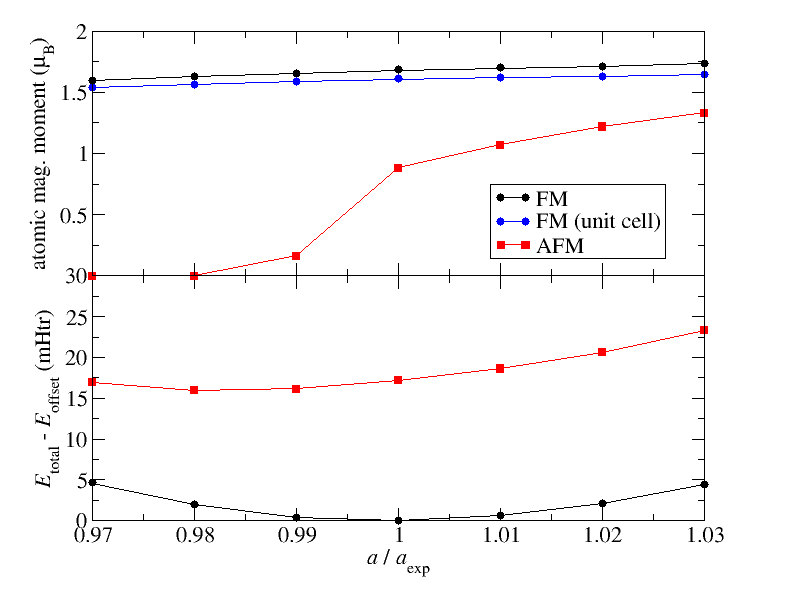1. Simple magnetic systems
Besides some f metals only very few element crystals feature a magnetic ground state: Fe, Co, Ni are ferromagnetic (FM) and Cr is antiferromagnetic (AFM). In this tutorial session we want to compare different magnetic configurations of several materials to determine their magnetic ground state.
1.1. hcp Co
hcp Co (in inpgen latsys='hdp') features the experimental lattice parameters and .
Starting from these values we determine the equilibrium PBE lattice constants for initial FM and AFM configurations. To
allow for the symmetry breaking related to the AFM setup we have to make sure that the two Co atoms are treated as unequal
by inpgen. This is done by adding different "fractional atomic numbers" to their atomic number:
2
27.01 1.0 1.0 1.0
27.02 -1.0 -1.0 -1.0
&factor 3.0 3.0 4.0
The fractional part is only used to find out whether two atoms may belong to the same group of symmetry equivalent atoms. There won't be any differences in the charges of the nuclei.
Generate in two subfolders (FM and AFM) the respective inp.xml file. In the AFM folder we modify the inp.xml file such
that the initial magnetization is antiferromagnetic. The initial magnetic moment for each atomSpecies is provided implicitly by
the spinUp and spinDown occupations of the electron states in atomSpecies/species/electronConfig/stateOccupation.
We note that the two Co atoms are placed in two different groups in atomGroups. Each atom group is associated with an
atom species by the entry in atomGroups/group/@species. But there only is a single atom species for both Co atoms. To obtain
an antiferromagnetic setup we thus have to duplicate the Co atom species and modify the copy to fit our needs. This means that we
have to rename the copy in the entry atomSpecies/species/@name to something like "Cobalt (Co) 2" and associate one of the
atom groups with this new species by adapting the related entry in atomGroups/group/@species. To put a sign on the magnetic
moment of that atom species we either have to manually exchange the entries in atomSpecies/species/electronConfig/stateOccupation/@spinUp
and atomSpecies/species/electronConfig/stateOccupation/@spinDown or let Fleur do that automatically by setting the
related switch atomSpecies/species/electronConfig/@flipSpins to "T".
Note that calculationSetup/magnetism/@jspins is by default 2 for this inp.xml file. This enables a magnetic calculation. Whenever you set up a unit cell containing at least one magnetic atom this is the default. However, there may also be situations in which one has to set this value by hand.
Keep c/a constant: What are the equilibrium lattice constants for both magnetic setups, what is their energy difference? The
magnetic moments for each atom type in each iteration can be obtained with grep magneticMoment out.xml. The entry
in magneticMomentsInMTSpheres/magneticMoment/@atomType hereby indicates the atom group. For the FM and the
AFM case: How do the magnetic moments for the two atoms depend on the lattice constant? Of course, the magnetic moments
obtained in this way only cover the charge that is within the respective MT spheres. In the FM case: The spin-dependend charge
for the whole unit cell in each iteration can be obtained with grep spinDependentCharge out.xml. Note that there are related
entries for the valence charge and entries for the complete charge in the unit cell. Don't mix them. For an example lattice
constant calculate from this the magnetic moment for the whole unit cell and divide it by two to obtain a value per atom. What
is the difference to the magnetic moment in the MT spheres?
Your results should be similar to what is sketched in the following plot.

2. Exercises
2.1. bcc Cr
bcc Cr features the experimental lattice constant of . Set up a conventional bcc unit cell with two atoms and perform calculations analogous to the Co example above. Calculate all the quantities that were also calculated for the Co example.
Results to be delivered: Plots for:
- total energy vs. lattice constant
- magnetic moment of 1st atom vs. lattice constant
Also the energy difference FM vs. AFM for the respective equilibrium lattice constants has to be calculated.
